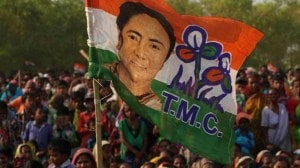- India
- International
Maharashtra swearing-in: Story of fall and rise
Suhas Palshikar writes: Collapse of MVA government resonates beyond state: It discredits efforts of Opposition unity, underscores crisis of state parties, signals expansion of BJP’s ideological claims.
 Suhas Palshikar writes: The resignation of Uddhav Thackeray has signaled a setback to the politics of forming a non-BJP coalition
Suhas Palshikar writes: The resignation of Uddhav Thackeray has signaled a setback to the politics of forming a non-BJP coalitionThere is a sense of déjà vu about the developments in Maharashtra. In state after state, it’s the same script. In Madhya Pradesh and Karnataka, we saw the removal of non-BJP governments due to defections and splits. In Maharashtra, this happened to the Shiv Sena instead of the Congress but the script was more or less the same. India’s parliamentary democracy has seen it all — defections, splits, controversies surrounding the role of presiding officers, judicial interventions and even videography of proceedings of the House. Right from the beginning of the current crisis, however, it was clear that Uddhav Thackeray had lost the majority and this had happened because of the desertion of his own party’s MLAs.
Two institutional issues have emerged from the political developments that unfolded in Maharashtra over the past week or so. One is about the appropriateness of judicial intervention and the other has to do with the inadequacy of the anti-defection law. Both need to be separately debated. But even as we mull over the institutional aspects, there are three broader factors which are politically central and have resonance beyond state politics.
The first has to do with the larger possibility of tackling the dominant party. The fall of the government in Maharashtra has underlined the hurdles in forging and consolidating an anti-BJP coalition. The Maha Vikas Aghadi (MVA) may have been opportunistic, it may have been a coalition of disparate parties, but it was nonetheless a state-level experiment of negotiating with the fact of one-party dominance.
In a dominant party system, the Opposition has no way of facing the dominant party except through a coalition. The MVA represented such an alliance. After the failure of the RJD-JD(U) alliance in Bihar, the MVA kindled hope in non-BJP circles that the BJP can be kept out of power through such an alliance. Like Bihar, in Maharashtra too, one partner in the non-BJP alliance was an erstwhile partner of the BJP. In Bihar, the ex-partner of the BJP went back to the BJP. In Maharashtra, though the Sena leadership continues to be opposed to the BJP, a majority of Sena MLAs demanded alliance with the BJP instead of the two Congress parties. It was argued that the core platform of the Shiv Sena being Hindutva, it’s ideologically consistent and necessary that Sena allies with the BJP. It is another matter that this argument came from the Shiv Sena rebels 30 months too late!
Thus the recent developments in Maharashtra witnessed a conflict between an argument about common ideology and shared existential challenges thrown up by one-party dominance. The resignation of Uddhav Thackeray has signaled a setback to the politics of forming a non-BJP coalition. The MVA did not have any concrete policy direction to distinguish itself from the BJP, nor the cohesion necessary to take on the dominant party. But it represented the possibility of taking on the BJP on the simple plank of anti-BJPism. The fall of the MVA government has put the brakes on future such attempts at the all-India level.

The second point that Maharashtra’s developments have highlighted pertains to the plight of state parties. With a vast majority of his MLAs deserting him, Uddhav Thackeray now finds himself isolated. He will be facing the toughest test of his party’s revival. This has thrown the state’s bipolar and four-cornered party system into disarray. At this moment, the future of the Shiv Sena seems quite uncertain, but this is not merely about the Shiv Sena.
In the last eight years, the BJP has been facing opposition of two kinds. One is from the Congress and the other is from state parties. While the former has been contained by the BJP, more or less, opposition from state parties has proved more formidable. From the JMM to Trinamool Congress, state parties have stood their ground against the BJP. But the split in the Shiv Sena suggests that despite the electoral resilience of state parties, their prospects are not very bright. For the BJP to expand and consolidate its dominance, it is necessary that state parties are diminished. In the context of that necessity, the fall of the Shiv Sena marks a tendency that may benefit the BJP.
In the BJP’s scheme of things, state parties were central in the 1990s as potential alliance partners and today they are central as targets to be demolished, or weakened. Splits and defections ensure that state parties will become weak and will either be forced to become secondary partners of the BJP or lose their relevance as major players in state politics. With two groups now claiming both the title of the party and the space that the Shiv Sena acquired over decades, Maharashtra will witness a tough battle between the two sections. This would probably mean that the primacy that the Shiv Sena enjoyed will be lost. The plight of the Shiv Sena today is thus a warning signal to other state parties.
After the current shock, it will take a long time for the Shiv Sena to revive itself. In all probability, it will not be able to play a significant role in the politics of the state for some time to come. Its marginalisation will, in a sense, represent the plight of many other state parties. The Janata Dal(S) in Karnataka is a case in point. If state parties lose their space, a major hurdle in the BJP’s path will be removed.
The third factor emerging from the current political complications in Maharashtra but having relevance beyond the state is the justification given by the rebel MLAs. The narrative woven around the rebellion was that the Shiv Sena was nurtured by the late Sena chief Balasaheb Thackeray as a party revolving around Hindutva. Therefore, alliance with the BJP is the only natural path in order to preserve Hindutva. This claim has been smoothly borrowed from the BJP. The BJP’s criticism that the Sena has given up Hindutva has always rattled the Shiv Sena and forced its leadership to assert its Hindutva credentials. From the Ayodhya issue to the controversy over Savarkar, the Shiv Sena was trapped by the BJP for being less vocal. In order to regain its space, once the Shiv Sena is out of power, it will be tempted to play the Hindutva card in order to corner the BJP.
Thus, while it may still be opposed to the BJP — because the humiliation hurled at the Shiv Sena leadership by the BJP will ensure that the two parties will be at odds — its rhetoric will in the long run help the BJP to further popularise Hindutva in Maharashtra. The political terrain will be occupied chiefly by the ideology of Hindutva. So, besides controlling a large state, the BJP may have gained ideologically from the Sena’s crisis in Maharashtra.
It is not merely one more state that has gone to the BJP; that in itself is a valuable prize. The fall of the MVA government has broader implications beyond Maharashtra. It has discredited efforts of Opposition unity, underscored the crisis of the state parties and, above all, signalled the expansion of the BJP’s ideological claims.
The writer, based in Pune, taught political science and is chief editor of Studies in Indian Politics.
EXPRESS OPINION
More Explained
Apr 26: Latest News
- 01
- 02
- 03
- 04
- 05











































